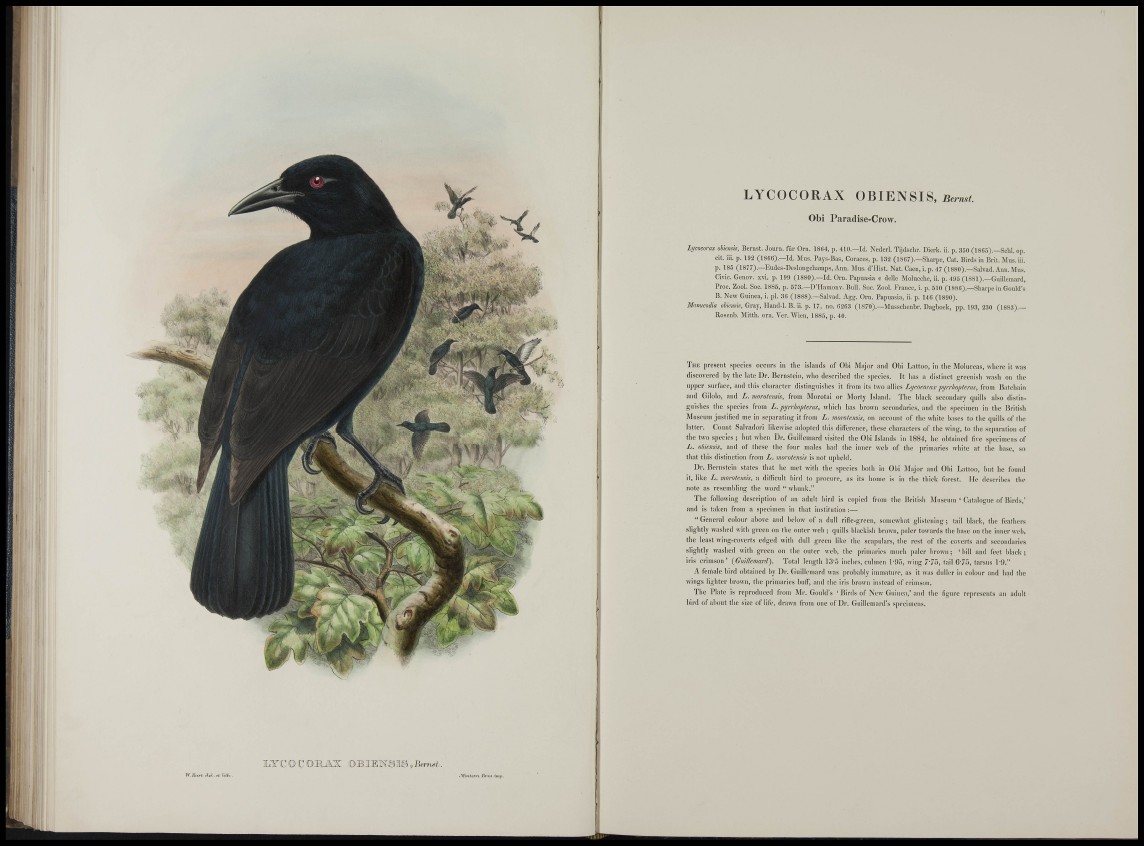
LYCOCORAX OBIENSIS,
Obi Paradise-Crow.
Lycocorax obiensis, Bernst. Journ. für Orn, 1864, p. 410.—Id. Nederl. Tijdschr. Dierk. ii. p. 350 (1805).—Sehl. op.
cit. iii. p. 192 (18G6).—Id. Mus. Pays-Bas, Coraces, p. 133 (1807).—Sharpe, Cat. Birds in Brit. Mus. iii.
p. 185 (1877).—Eudes-Deslongchamps, Ann. Mus. d'Hist. Nat. Caen, i. p. 47 (1880).—Salvad. Ann. Mus.
Civic. Genov. xvi. p. 199 (1880).—Id. Orn. Papuasia e delle Molucche, ii. p. 495 (1881).—Guillemard,
Proc. Zool. Soc. 1885, p. 573.—D'Hamonv. Bull. Soc. Zool. France, i. p. 510 (1886).—Sharpe in Gould's
B. New Guinea, i. pi. 36 (1888).—Salvad. Agg. Orn. Papuasia, ii. p. 146 (1890).
Mamtcodia oUemis, Gray, Hand-1. B. ii. p. 17, no. 6263 (1870).—Musschenbr. Dagboek, pp. 193, 230 (1883).—
Rosenb. Mitth. orn. Ver. Wien, 1885, p. 40.
THE i)re,sent s|)ccies occurs in the Islands of Ohi Major and Obi Lattoo, in tlie Mohiccas, where it was
discovered by tlic late Dr. Bernstein, who described the species. It has a distinct greenish wash on the
upper surface, and this cliaracter distlngiii.shes it from its two allies Ltjcocorax pyrrliopleriis, from Batchalii
and Gilolo, and L. moroiensis, from Morotai or Morty Island. The Idack secondary quills al.so dlsllngnlslies
tlie species from L. ¡njrrhnpterus, which has brown secondaries, and the specimen In the lirltlsh
Museum justified me In separating It from L. morolensk, on account of the white bases to the quills of the
latter. Count Salvador! likewise adopted this dlil'erenee, these characters of the wing, to the separation of
the two species ; l)ut when Dr. Guillemard visited the 01)1 Islands In 1884, he obtained five specimens of
L. obiensis, and of these the four males had the Inner web of the ])rlmarlcs white at the base, so
that this distinction fi-om L. morotenm Is not upheld.
Dr. Bernstein states that he met with the species both in Obi Major and Obi Lattoo, but he found
it, like L. morotenm, a difficult bird to procure, as Its home Is in the thick forest. He describes the
note as resembling the word"whunk."
The following description of an adult bird Is copied from the Britisli Museum ' Catalogue of Birds,'
and Is taken from a specimen in tliat institution :—
"General colour above and below of a dull rifle-green, somewhat glistening; tall black, the feathers
slightly washed with green on the outer web ; quills blackish brown, paler towards the base on tlie Inner web,
the least wing-coverts edged with dull green like the scapulars, the rest of the coverts and secondaries
slightly washed with green on the outer web, the primaries mucli |)aler brown; ' bill and feet black ;
iris crimson' (GmUemard'). Total length IS'O Inches, culmen I'Oo, wing 7-75, tail 6-75, tarsus 1-9."
A female bird olitalned by Dr. Guillcinard was jn-obably Immature, as It was duller In colour and had the
wings lighter brow^n, the primaries bulF, and tlie Iris brown Instead of crimson.
The Plate Is reproduced from Mr. Gould's ' Birds of New Guinea,' and the figure represents an adult
bird of about the size of life, drawn from one of Dr. Gulllemard's specimens.
i Y C O C ÌÌTR A X OBIEM'SIB,
TV. T . LITH'. .Mbilei-n 23ivv«.WJJ.